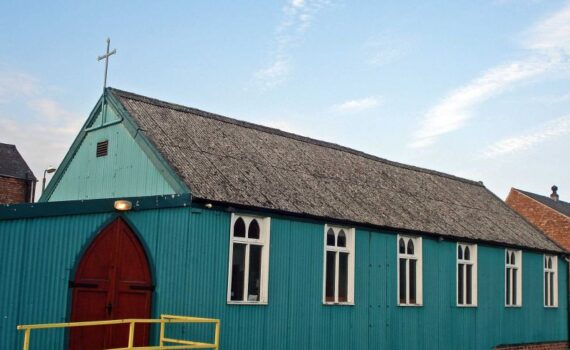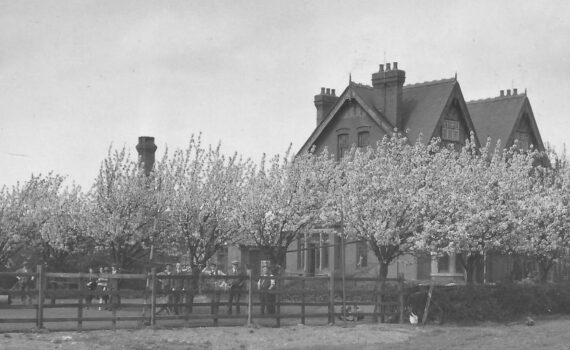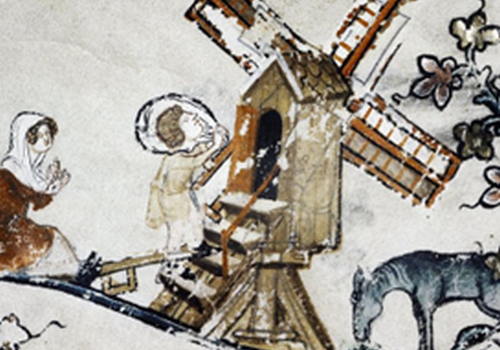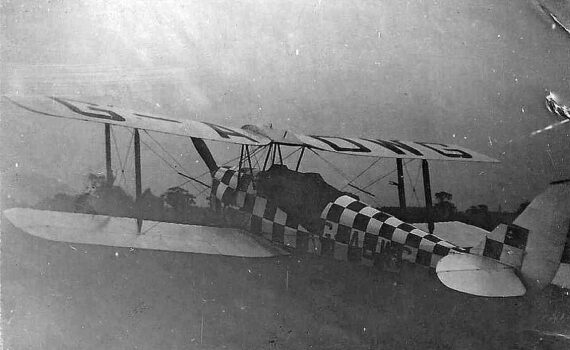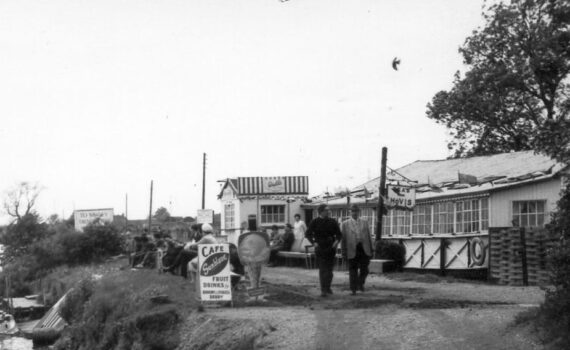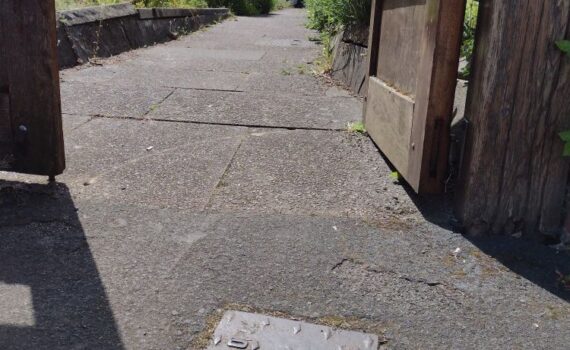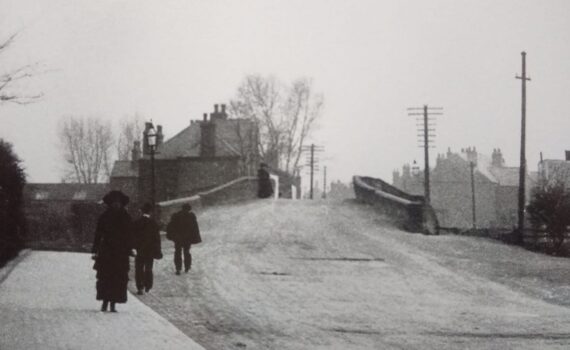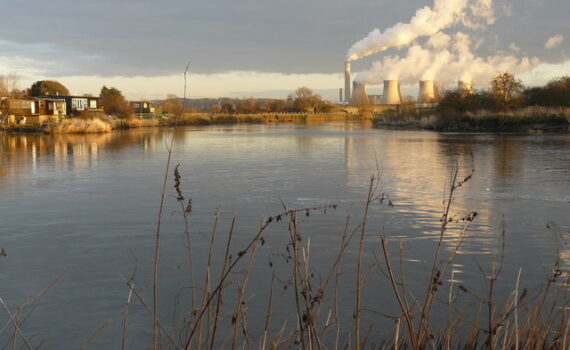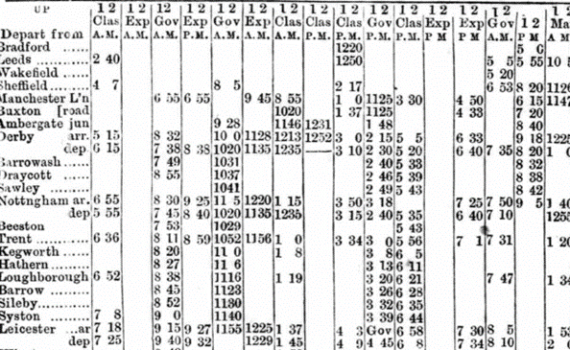Adapted from an article by Judy Kingscott in the Sawley and District Historical Society Newsletter, March 2008 By the start of the 20th century, New Sawley was growing quickly, with much of Victoria Street and Harrington Street being completed in the 1890s. And over 1,100 people were living in Sawley parish, but beyond the railway line. Money was raised to buy two substantial plots of land in New Sawley and set up two chapels made from corrugated iron sheets. The building erected in Wilsthorpe Lane – opposite Hill’s lace factory (later Concordia) – St Mary’s, was consecrated as a church in 1909 and services are still held there. A fund has been in existence for many years to raise money to improve the building; garden parties, Christmas bazars, and other events are regularly held to this end. Marjorie Bennet (1914-1995), who featured in last month’s blog ‘A Bridge Too Far’, grew up on Wilsthorpe Road, and remained faithful to St Marys, even after she’d moved to Long Eaton. Other people have long and fond associations with St Mary’s and still worship there. St Marys is one of only six ‘tin tabernacles’ left in Derbyshire. Three of these are in Long […]
Posts - Articles
Narrow Bridge Cottages were on the bend in the road to Trent Lock, between the road and the footbridge over the Erewash Canal. The cottages dated from the early 19th century, or earlier. There seem to have been 2 large cottages by the bridge and another 6 cottages in a row by the bend road. Originally, they were mostly in Sawley Parish, but from 1921 they were taken over by Long Eaton, along with the rest of New Sawley. In 1900 there was a typhoid outbreak at the cottages. It was attributed to drinking water, but the Sawley Parish Council was told that the property was ‘in a very insanitary condition’. In 1901 the Council heard about an overflowing cesspit at Narrow Bridge Cottages. Although the owner, Mr Tingle, replied that he had just spent £40 on improvements. The houses had been owned for many years by the Tingle family, who’d been boatbuilders. Although in 1904 six houses (presumably the terrace) were advertised for sale as copyhold (a sort of freehold) but don’t seem to have sold. In May 1905 the body of a newborn baby was found in the canal nearby, wrapped in brown paper. Twenty years earlier, the […]
Many local people will remember the Erewash Princess as a pleasure cruiser on local waterways in the late1960s and early 1970s. But where did she come from, and what happened to her? In 1966 four members of the Inland Waterways Association were fighting to keep the Erewash Canal open. They bought a 2nd hand 36ft boat and named her ‘Erewash Princess’. They formed their own company and planned to run boat trips at weekends and most evenings. The Erewash Princess was 36ft long and constructed from wood, with a diesel engine. She could carry up to 55 passengers. She was built in 1927, and it seems she was operated on the River Severn, and then on the River Dee at Chester. But the details of her early history (and her original name) are currently unknown. In May 1966, one of the new owners – Derrick Alsop, who lived in Toton – started operating a service every Saturday and Sunday between Sandiacre and Trent Lock. It left Sandiacre at 2pm every Saturday and Sunday, stopping at Long Eaton (at the old coal wharf near the fire station) and on to Trent Lock. It then made 3 more runs from Long Eaton […]
In 1900, apart from the Midland Bank at the corner of Tamworth Road, there were only two pairs of semi-detached houses on Wilsthorpe Lane (now 16-22, Wilsthorpe Road). In 1900 Samuel Hill submitted his first plans for a single-storey lace factory opposite St Mary’s Church. It was extended over the following 7 years, including a large house ‘The Limes’ separated from the factory by greenhouses. By 1910 Birchwood Mills (1906) and Atlas Mills (1910) had been completed by other developers, along with Ruskin Avenue and Lime Grove and more houses along Wilsthorpe Lane. The factory was sold to Concordia in about 1925, but the Hill family retained The Limes. * * The story of the Hill family and their factories will be covered in next blog post. * * In 1930 George Hill formed The New Sawley Club Limited at The Limes, with the directors being himself and W. Scott of Victoria Road. Although the Club may have already been operating for a few years. As well as a bar, the club had a bowling green and tennis courts. The club didn’t seem to thrive and by 1933 the tennis courts were being advertised for let. The nearby pond (now […]
Sawley was originally known as Salloe. In the Domesday book it was spelled ‘Salle’. A ‘Salh’ or ‘sealh’ was the Old English (Anglo-Saxon) name for a willow tree. The common varieties of willow, of the type that grow along the Trent, are still called sallow. The name was similar in Old Norse (selja) so there would have been little reason to change it when Sawley was part of the Danelaw. ‘Ley’ at the end of an Anglo-Saxon placename usually means clearing in a wood. But the ‘Salle’ in the (early Norman) Domesday book suggests the modern name just evolved from Salle/Salloe over the subsequent years. But we don’t know the origins for sure. For example, the Old English name for a hill/hillock is ‘hlāw’. And the area around Sawley church is on higher ground. Which would have been very significant to farmers before the flood banks were built. In contrast, Wilsthorpe is clearly a Danelaw (Viking) name. ‘Thorpe’ usually meant a small hamlet within a larger parish, and most ‘..thorpe’ places are still quite small. The first part of a placename was usually the person who held the land. So, Wil or Wifel, or something like that. […]
The Harriman Family Grange Gardens were opposite Sawley Grange Farm, on the other (reservoir) side of Draycott Road, when it used to go to Draycott! Although always referred to as ‘Grange Gardens, Sawley’ it was (just) in Breaston parish. The image above shows an 1890s map superimposed on a modern air photo. The story seems to start with the Harriman family … Thomas Harriman was born in Hathern in 1812. He married Mary Frearson from Sawley in 1838. At first, they lived near Nottingham, but by 1846 they’d moved to Sawley Grange. Their children were: Annie (1842-1898) William (1844-1927) Elizabeth (1846- Mary (1848-1882) Grace (1851-1934) Mary (the mother) died in 1851 probably while, or soon after, giving birth to Grace. In 1860 Thomas got married again, to Zillah Briggs. By 1871 the family had moved to Draycott where Thomas worked as a brewery agent. But Thomas still owned over 12 acres of land, whilst the 3 younger daughters had just over an acre each (Annie was married by then). Elizabeth and Mary were still at home, both working as governesses. Grace (pictured) was probably living at home too, though she was away on the night of the 1871 census. […]
When the ‘London-Yorkshire Motorway’ (the M1) was being designed in the mid-1950s, the plan was for the whole stretch across the Trent near Sawley to be an elevated viaduct of 40ft high arches, – 20 arches north of the Trent and 20 to the south – so as not to block the flood plain. Then, in 1957, a scale model of the whole area was built at the Government Hydraulics Research Station at Wallingford, Berks. The model represented about 5½ miles of the Trent and 1½ miles of the Derwent valleys, including bridges, flood banks etc. The model covered 3,200ft2 (298m2); an area equivalent area to about 1.15 tennis courts, or (in old money) 14.5 London buses. Water was released across the model to represent a real-world flow of 35,000 cubic feet per second (991.09 m³/s) – the worst flood in recent history – which covered the valley to a depth of 3ft over a width of 8,000ft. The object of the modelling was to ensure that building the motorway would not cause the flood level upstream to rise more than another 3 inches. The scientists found that the arches would be far less effective south of the Trent […]
There was once a windmill in New Sawley. The site is between Birchwood Ave and Hawthorne Ave, near the bends on the Twitchell. Sawley Windmill in 1835 – the miller’s cottage is by the road, further along the Twitchell, near the boundary with Long Eaton A later map showing the windmill between the railway (before Sawley Junction) and the canal bridge. It was a post mill – a relatively simple mechanism in which the whole wooden structure had to be moved around a central post to keep the sails facing the wind. Though sometimes the structure would sit on a round brick-built base. The design had been used in England since the 12th century, though its not known when the mill in Sawley was built. Later tower windmills had a fixed structure with just a moveable top section, which meant they could be much taller, with larger sails. One of the few surviving post mills in England is the Cat and Fiddle Mill, near Dale Abbey (built in 1788). Cat and Fiddle © Copyright Garth Newton (Creative Commons Licence). The earliest newspaper reference to the Sawley windmill is 1794. In 1799 the mill was put up for sale. In 1801 […]
In the 1940s and 50s (and probably before) the railway ‘North Curve’ between Sawley Junction and Trent Station was used to accommodate the Royal Train overnight. In August 1940, King George VI and Queen Elizabeth, on their way from London to Derby, had their sleeping coach shunted on to the North Curve, with the local Home Guard providing the guard for the night. In June 1949 Princess Elizabeth and the Duke of Edinburgh were visiting Nottingham and spent the night on the Royal Train on the North Curve. The (now) Queen Elizabeth and Duke of Edinburgh spent a night in the same place on 4-5 July 1955 when attending the Royal Show at Wollaton Hall. Royal Train between Trent and Nottingham in 1949 The Royal Train was there again in March 1957 and October 1958. During one of these visits, Prince Philip wandered into Trent Station. He was interested in the booking office ticket system, and was allowed to produce some tickets. The booking clerk was in trouble the next day when his books did not balance. Prince Philip also decided to walk over to Trent North signalbox. The Trent staff telephoned to warn the signalman he was coming, but […]
Cobham Tiger Moth at Wilsthorpe In September 1937 an Air Display was held in New Sawley. Sir Alan Cobham’s flying circus brought two airliners (including a prototype Handley Page Hinaidi), an autogyro and several light aircraft to a field off Wilsthorpe Lane. Miss Joan Meakin performed aerobatics in a glider, whilst describing her actions over the radio. In another event 3 aircraft with the wings joined together by ribbons, looped their aircraft in formation. This event also saw the first public demonstration of the GQ parachute. Local people were offered flights from 4/ each Handley Page airliner
For many years the wooden Riverside Café stood at Trent Lock, at the end of the footpath that runs from the back of the ‘Trent Lock’ pub, alongside the triangular pond, nearly opposite the Scout Activity Centre. It’s not clear when the Riverside Café was built, but the first café at Trent Lock was opened in 1894 by Jane Rice (1858-1948). Her husband, Thomas Rice, was the ferryman at Trent Lock, whilst Thomas’s father had been running the Erewash Navigation Inn. Mrs Rice started the business at The Cottage/The White Cottage (perhaps the white cottage behind ‘The Cabin’ next to Trent Villa). In 1895 she moved to the newly built Trent Villa (the large Victorian house just west of the ‘Trent Lock’ pub). Trent Villa 1896 1921 After Thomas Maltby drowned in 1900, Thomas Rice took over the Erewash Navigation, with Jane taking over after Thomas died. At some point the wooden café was built beside the Trent on land rented from John Stevenson Grammar at Great Grounds Farm. By 1921 Jane’s son William Henry Rice was running a cafe at ‘The Bungalow, Riverside’, having previously worked for the River section of the Nottingham Fire Brigade. His brother, Tom Rice (1885-1970) […]
This photo from about 1895 shows an outing of local licensed victuallers on the Erewash Canal opposite the Nelson Hotel (now called the Barge Inn). Herbert Maltby of the Erewash Navigation, sitting at the rudder (on the far right) owned the boat, a converted lifeboat. Second from the right is Edward Carter, then licensee of the Blue Bell who later ran Carters’ mineral water in Sawley. Mr Beers of the Harrington Arms is just left of the engine in the middle of the boat. William Johnson (barman at the Erewash Navigation) is standing on the bow. Next to him are Mr Tanser of the Nelson and then Tom Meakin of the Tiger Inn. In 1894 the license to the Erewash Navigation Inn at Trent Lock was temporarily transferred from John Rice to Herbert Maltby, an agent for a brewery in Loughborough. Herbert and his wife Emma were from Hoveringham (by the Trent between Nottingham and Newark). This advertisement appeared in the Long Eaton Advertiser in February 1895. They stayed at the pub nearly 6 years, before leaving in early 1900. By 9th March Emma and their children had already moved to a house in Long Eaton, while Herbert remained to […]
A reader has spotted several drain and meter covers in Sawley manufactured by S J Claye Ltd of Long Eaton. Samuel John Claye opened a factory in Long Eaton in 1850. The site, between Huss’s Lane and Main Street had been the Manor House farm and the main site continued to be known as Manorhouse Works. It was well known for producing railway wagons for the Midland Railway. Many men from Sawley were employed at the works. Claye was sued for bankruptcy 1882 but carried on business until his death in 1887. He had himself a large house built on the other side of Main Street. The house ‘Belfield’ became Southlands Old People’s Home. It was demolished in 2022. The wagon works carried on as a limited company, but gradually fell into decline and the company was sold in 1937. Most of the buildings were demolished in the 1960s. The main site is now the Tapper’s Harker pub. The meter cover in Sawley is also marked LEUDC, so was presumably installed after LEUDC took over Old Sawley in 1934. But we thought Clayes only made railway wagons. Does anyone know more about other items made by Clayes? And another question […]
The original bridge over the canal on the road to Long Eaton (just past Magnet Garage) was built at the same time as the Erewash Canal, about 1778, one of 25 bridges along its length. It was an old ‘hogsback’ or humpback bridge and by the late 19th century it had become a bit of a bottleneck. It was just outside the parish boundary and thus the responsibility of Long Eaton Town Council. In 1883 the council received tenders to replace both this (Sawley Road) bridge and the canal bridge on Wilsthorpe Lane (Derby Road), but only the latter was done. By 1901 Long Eaton Council were complaining that Sawley Road bridge was dangerous and a disgrace to the town. If a steam roller driver wanted to go to Sawley, he had to go via Breaston. It didn’t help that when the council ran a water main over the bridge, they raised the footway to cover it, leaving the parapet on one side of the bridge only 28” (71cm) high. In 1905 a Castle Donington man fell over the side late at night and died. In 1911 the old bridge was demolished and replaced by the current structure. Photo […]
Sawley Junction Station (now Long Eaton Station) was opened by the Midland Railway in 1888. The Midland Railway became part of the London, Midland & Scottish (LMS) Railway in 1923. The LMS was nationalised in 1948 and became part of British Railways (known as British Rail from 1965). This is the back cover of the April 1958 edition of British Railways – London Midland Region Magazine.
As early as 1889 there were discussions about whether Sawley should have gas or electric street lighting, as it had neither at the time. This was rather ambitious, as small-scale electrical supplies were only just beginning to appear in Britain. As it turned out, Sawley only received gas lighting in 1897, about the same time Long Eaton was converting to electricity. The gas lights themselves were donated by Ernest Terah Hooley. A large crowd gathered to see them first lit on 31st March 1897, which was followed by a dinner at the Harrington Arms. The rector (Rev E A Clarke) lit the first lamp. Sawley’s first employed gas lighter was Stephen Smith. Harrington Mill (off Wilsthorpe Road) set up its own electric lighting system in the 1890s. In 1899 Long Eaton council decided to install their own electric cables and lighting, powered by a coal-fired generating plant between Milner Road and the Erewash Canal. This opened in 1903 using a 3-wire direct current system. Three years later it was converted to alternating current. The system was a financial success for the council and mains electricity seems to have reached New Sawley about 1913. In 1931, when the Wilsthorpe Road […]
In 1873, Sawley had plenty of shops, but those who needed to travel, and didn’t have their own horse, would have relied on the railway or local carriers (see below). Bicycles had been invented but didn’t really take off until the late 1880s, with developments like the pneumatic tyre. Roads had originally been maintained by the parish, but the 1862 Highways Act transferred the responsibility for most roads to the County Surveyor. The roads would have used the Macadam techniques, e.g. medium-sized stones at the bottom and smaller stones on top. But they’d have been muddy when wet and dusty in dry weather as they weren’t sealed with tar (tar-macadam, i.e. ‘tarmac’) until the 20th century. Canals and rivers were still used for transporting bulk cargo, although they’d lost a lot of business to the railways. There were no passenger river services, apart from the ferries at Trent Lock (across to Cliff Farm and the path to Red Hill) and Thrumpton (a long walk down Meadow Lane/Pasture Lane, Long Eaton). Carriers The carriers were men with horse-drawn wagons who provided a regular service, usually on market days, to towns or cities, and then back later the same day. In more […]
Magnet Garage (now Long Eaton Garage Services) is on Tamworth Road, just before the Erewash Canal Bridge. In 1920 the proprietor was Albert Robert Bott. He was born in Milford in 1881. His father was a traction engine maker and Albert started work as an engine fitter. During the Great War he served with the Tank Corps before transferring to the Royal Flying Corps and becoming a photographer at No.1 Aeroplane Supply Depot at St Omer, France. In about 1928 John Thomas (Jack) Allen took over the garage, having previously worked for Rolls Royce in Derby. He was born in Long Eaton but grew up in Myrtle Avenue, New Sawley. In 1939 he was living nearby at 58 Tamworth Road. He was still running the garage in the late 1950s. The nearby Sea Scout facility next to the canal was opened in about 1956,
Between 1934 and 2000 Sawley did not have its own council and the signs by the roads entering the village said LONG EATON. In 1981 two local lads decided to fix that. One of them now runs this website.
Here are some advertisements from the 1730s and 1750 found in the Derby Mercury newspaper. Whilst its not (yet) possible to work out which houses are referred to; it’s worth looking at the meaning of some of the terms used. The Derby Mercury ran from 1732 to 1900. From 1882 to 2008 Sawley’s local paper was the Long Eaton Advertiser. Messuage. This means a house together with its outbuildings and adjacent land. The legal definition is still current, but the term was often used in adverts for houses in the 18th and 19th century. Lady Day (the Feast of the Annunciation) is 25th March. It is the first of the English quarter days (the others being Midsummer Day (24 June), Michaelmas (29 September) and Christmas (25 December). The cross-quarter days are Candlemas (2 February), May Day (1 May), Lammas (1 August), and All Hallows (1 November). Until 1752 Lady Day was the first day of the civil year in England, Wales and the American colonies (from 1752 it became 1 January to harmonise with Scotland). In the same year the Julian calendar was replaced by the Gregorian calendar, which meant dates advanced by 11 days. So, the ‘old’ Lady Day […]

